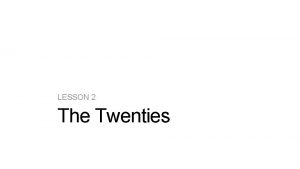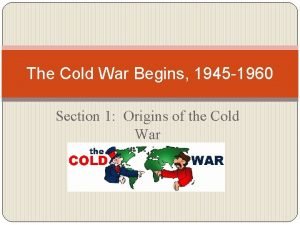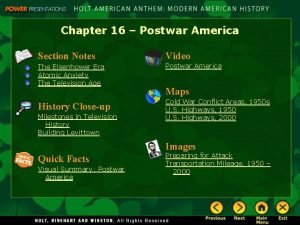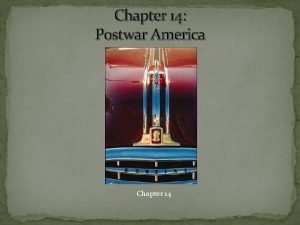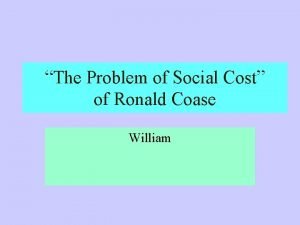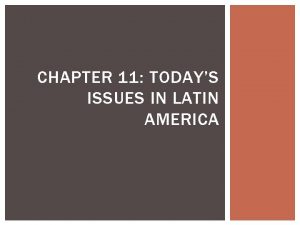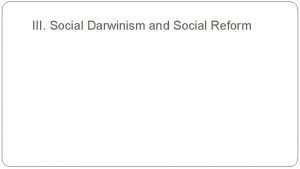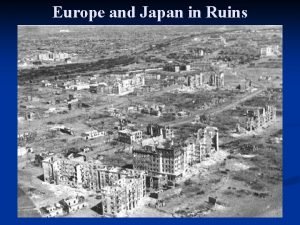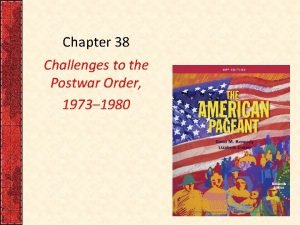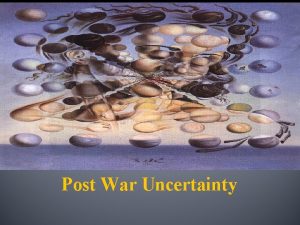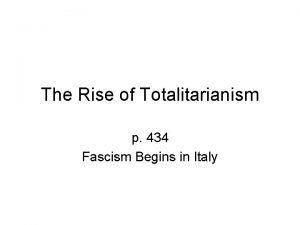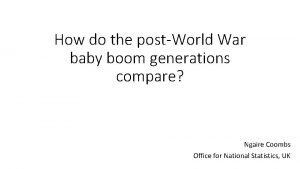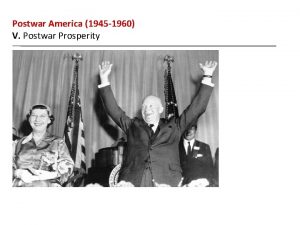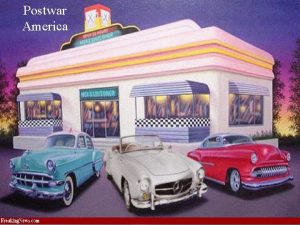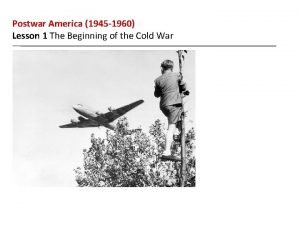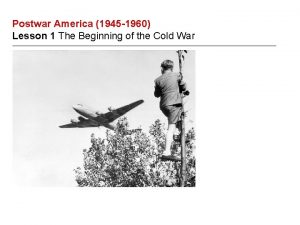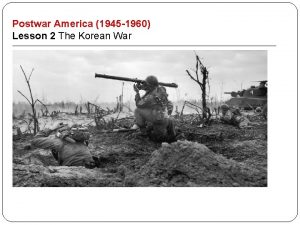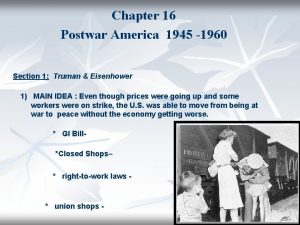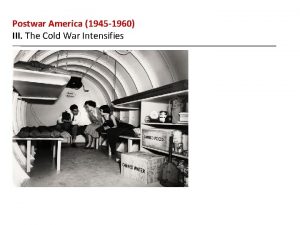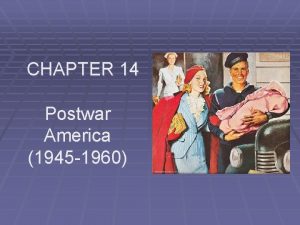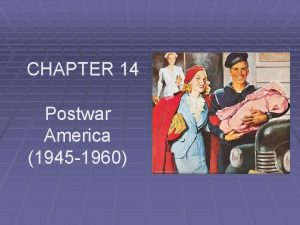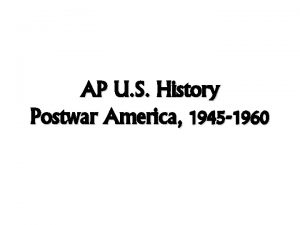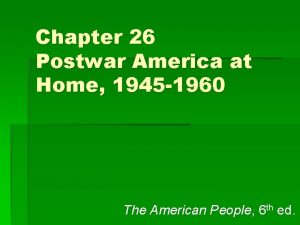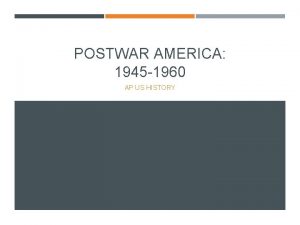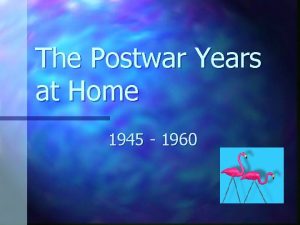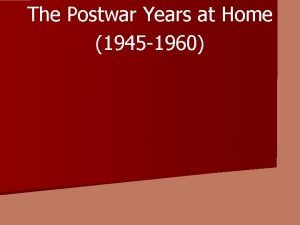Postwar America 1945 1960 Lesson 7 Social Issues






















- Slides: 22

Postwar America (1945 -1960) Lesson 7 Social Issues of the 1950 s

Postwar America (1945 -1960) Lesson 7 Social Issues of the 1950 s Learning Objectives • • • Summarize the arguments made by critics who rejected the culture of the fifties. Describe the causes and effects of urban and rural poverty. Explain the problems that many minority groups faced in the postwar era.

Postwar America (1945 -1960) Lesson 7 Social Issues of the 1950 s Key Terms • • • beatniks rock-and-roll Elvis Presley urban renewal termination policy

Critics and Rebels Emerge Despite the prosperity of the 1950 s, not all people benefited. Some felt let out of the era's prosperity. Others, who had obtained more wealth, wondered whether all of the material things they acquired had actually led to a better life. The discontents of the 1950 s would manifest the first signs of the dissent that would dominate the 1960 s.

Critics and Rebels Emerge • • • Cultural Movements Against Conformity The Impact of the Beat Generation on American Society A New Style of Music

Critics and Rebels Emerge �Some people thought living in suburbs, shopping centers, and new gadgets meant a better life. �Too much conformity �Individualism sacrificed to fit in �Advertising molded public tastes �Alienation or cut off from mainstream �Catcher in the Rye – JD Salinger – mocked the phoniness of adult society �Betty Friedan’s – The Feminine Mystique (1963) was about the plight of the suburban housewife in the 1950’s. – the problem that has no name �“Is this all? ”

The Impact of the Beat Generation on American Society �Beatniks – group of writers and artists that refused to conform Displayed their dislike of American Society by dress and speech Many Americans were outraged at them �Rebel without a Cause (James Dean) and The Wild One (Marlon Brand 0) – about rebelling against the establishment – became role models for disenchanted teenagers

A New Style of Music �Rock and Roll – a blend of gospel, blues, jazz, boogie woogie and R and B. �Started in the 1950’s �Chuck Berry live �Radio broke the color barrier �Elvis Presley – early rock and roll artist – “Heartbreak Hotel” �Berry, Presley, Fats Domino, Little Richard, and Ray Charles, Buddy Holly �Would influence the Beatles and Rolling Stones

Critics and Rebels Emerge Some popular entertainment of the 1950 s, including movies such as Rebel Without a Cause, questioned the values of the middle class.

Poverty in the Cities and Rural Areas Behind the new household appliances, the spreading suburbs, the burgeoning shopping malls, and the ribbons of highways was a very different United States. It was a nation of urban slums, desperate rural poverty, and discrimination. People who were poor and dispossessed were well hidden.

Poverty in the Cities and Rural Areas • • Effects of Migration on Cities Migration from Rural Areas

Poverty in the Cities and Rural Areas �Michael Harrington’s Other America argued about African American poor in cites, white poor in Appalachia, and Hispanics in southwest. �White middle class left cities for suburbs – took their taxes with them Schools, garbage, street repair all suffered in cities �Urban renewal – government cleared lands to revitalize cities but most often backfired �Dubuque, IA �As farms got bigger, many small families sold and moved to cities increasing poor

Poverty in the Cities and Rural Areas Not everyone experienced prosperity during this time. Stubborn areas of long-term poverty, such as this part of rural West Virginia, saw little benefit from the boom times.

Poverty in the Cities and Rural Areas Analyze Data What push and pull factors might have affected Americans in the South during this period?

Poverty in the Cities and Rural Areas Analyze Graphs This graph shows how poverty levels changed from 1955– 2005. Overall, what was the poverty trend in this period?

Struggles of Minorities During the postwar years, the battle for civil rights in the South began to gain headlines. Yet, in the same time period, African Americans and other minorities also fought for equality in the urban north and west. Central to their struggles were efforts to overcome housing and employment discrimination.

Struggles of Minorities • • • Discrimination against Puerto Ricans Labor Conditions and Mexicans Americanization of Native Americans

Struggles of Minorities �Puerto Ricans found moving to New York City hard �Ernesto Galarza tried to organize labor unions for farm labors to pay better and stop exploitation �Termination policy – effort to stop tribal governments and move all Native Americans to the cities Did not work

Struggles of Minorities Puerto Ricans, like previous waves of immigrants, formed communities in specific urban neighborhoods.

Quiz: Critics and Rebels Emerge Why was theme of alienation popular in many movies and novels in the 1950 s? A. B. C. D. Many Americans felt they had been left out of mainstream society. Many Americans felt that material possessions were overvalued. Many Americans felt that the quality of life had not improved. Many Americans felt that advertising held too much power.

Quiz: Poverty in the Cities and Rural Areas Which was the main cause for the economic downturn in cities in the 1950 s? A. B. C. D. Federal public housing projects concentrated poverty in certain areas. Cities lost tax revenue when middle-class families moved to the suburbs. Large numbers of minorities migrated to cities in search of employment. Urban renewal projects drove people from their neighborhoods.

Quiz: Struggles of Minorities What impact would the termination policy have on Native Americans? A. Native Americans would be relocated from their reservations to the nation’s cities. B. Native Americans would be forced to work in degrading conditions or risk losing their jobs. C. Native Americans would receive help from the government to improve services in their communities. D. Native Americans would be forced to assimilate to white society or risk losing health and welfare benefits.
 Postwar issues lesson 2
Postwar issues lesson 2 The cold war begins 1945-1960
The cold war begins 1945-1960 American struggle with postwar issues
American struggle with postwar issues Chapter 19 section 3 popular culture
Chapter 19 section 3 popular culture Chapter 16 postwar america
Chapter 16 postwar america Lesson 1 truman and eisenhower
Lesson 1 truman and eisenhower Coase 1960 the problem of social cost
Coase 1960 the problem of social cost Chapter 11 today's issues in latin america
Chapter 11 today's issues in latin america America america you mean the world to me
America america you mean the world to me America 2 europe
America 2 europe Repetition in let america be america again
Repetition in let america be america again Why is it called latin america
Why is it called latin america Happening e performance
Happening e performance What was reform darwinism?
What was reform darwinism? Social thinking and social influence
Social thinking and social influence Social thinking social influence social relations
Social thinking social influence social relations Kerner commission apush
Kerner commission apush Note two effects of allied bombing raids on japan.
Note two effects of allied bombing raids on japan. Chapter 38 challenges to the postwar order
Chapter 38 challenges to the postwar order Chapter 31 section 1 postwar uncertainty
Chapter 31 section 1 postwar uncertainty How did postwar disillusionment contribute to
How did postwar disillusionment contribute to Postwar baby boom
Postwar baby boom How did the treaty of versailles affect postwar germany?
How did the treaty of versailles affect postwar germany?
